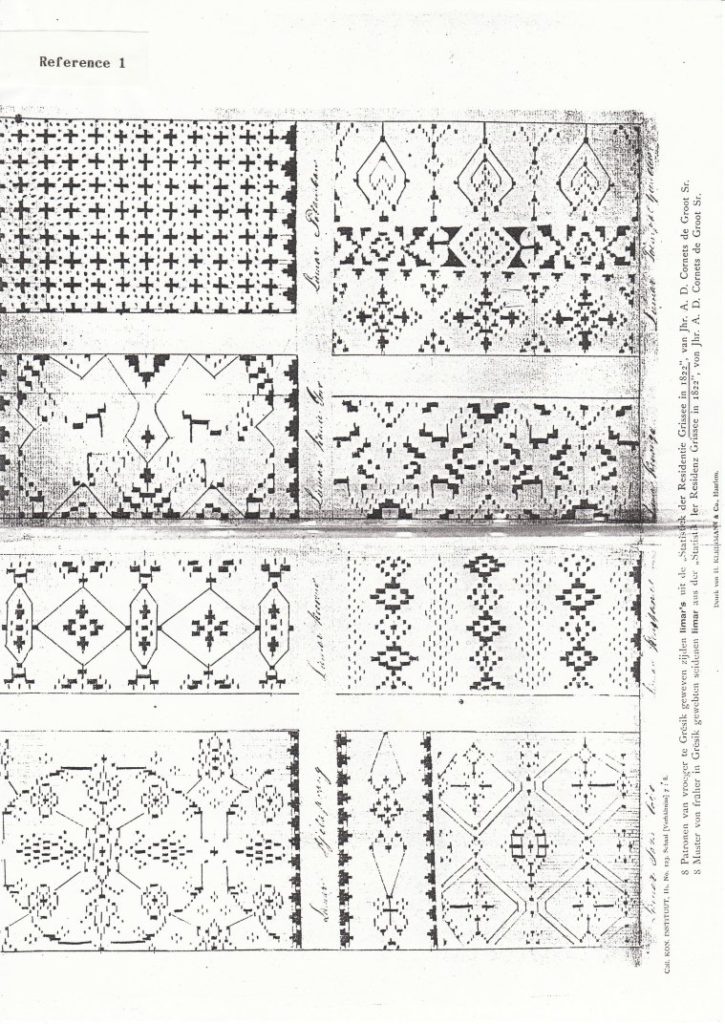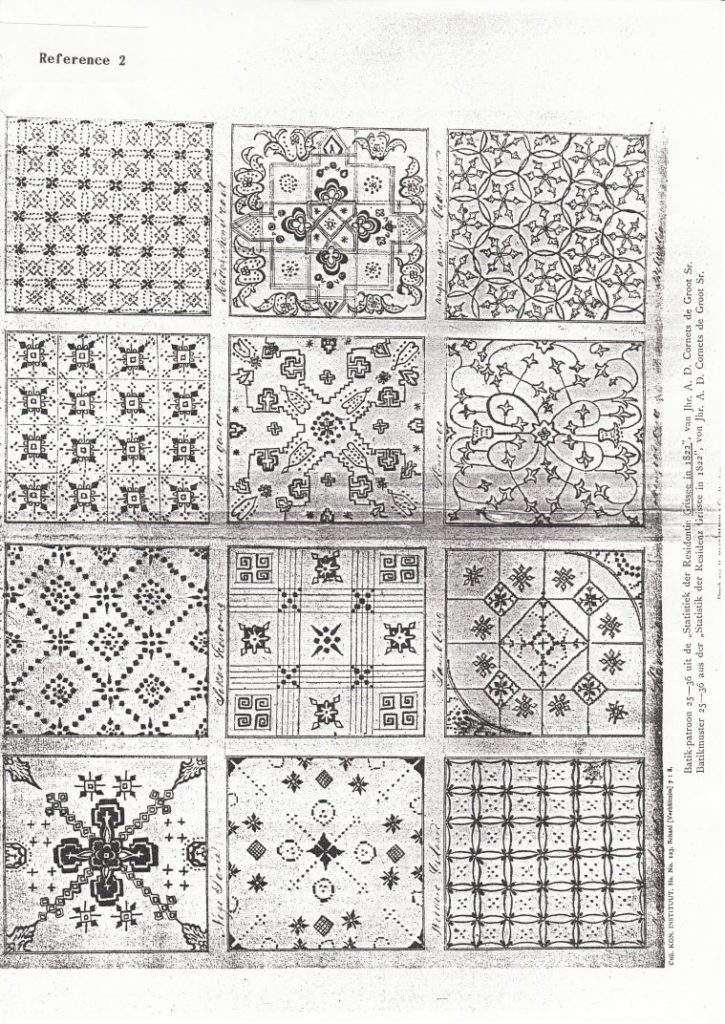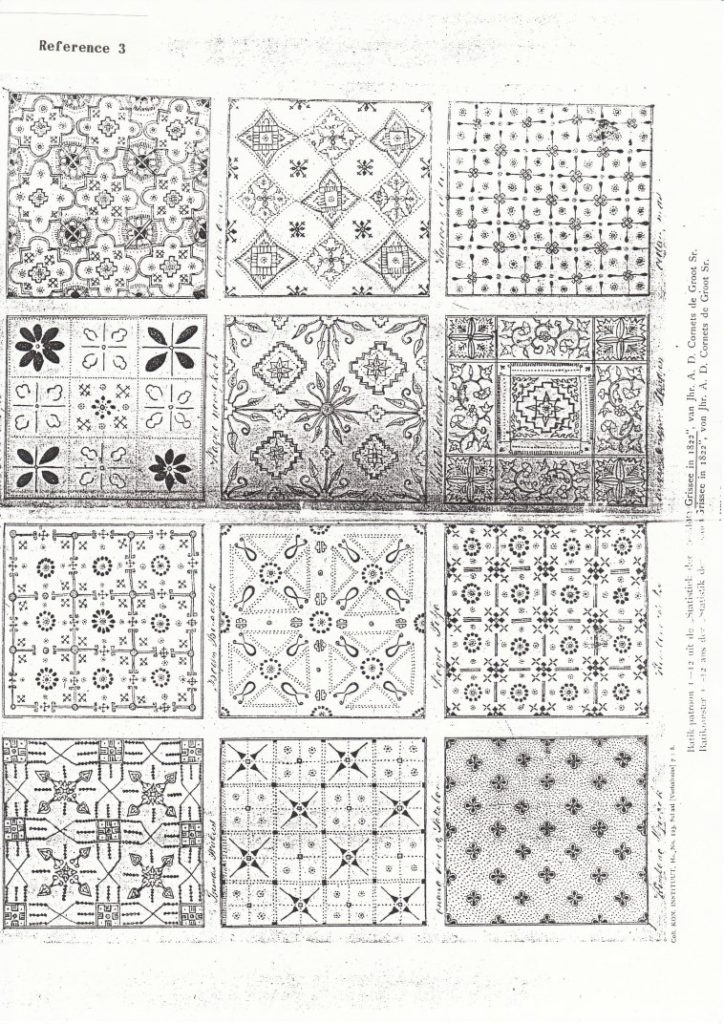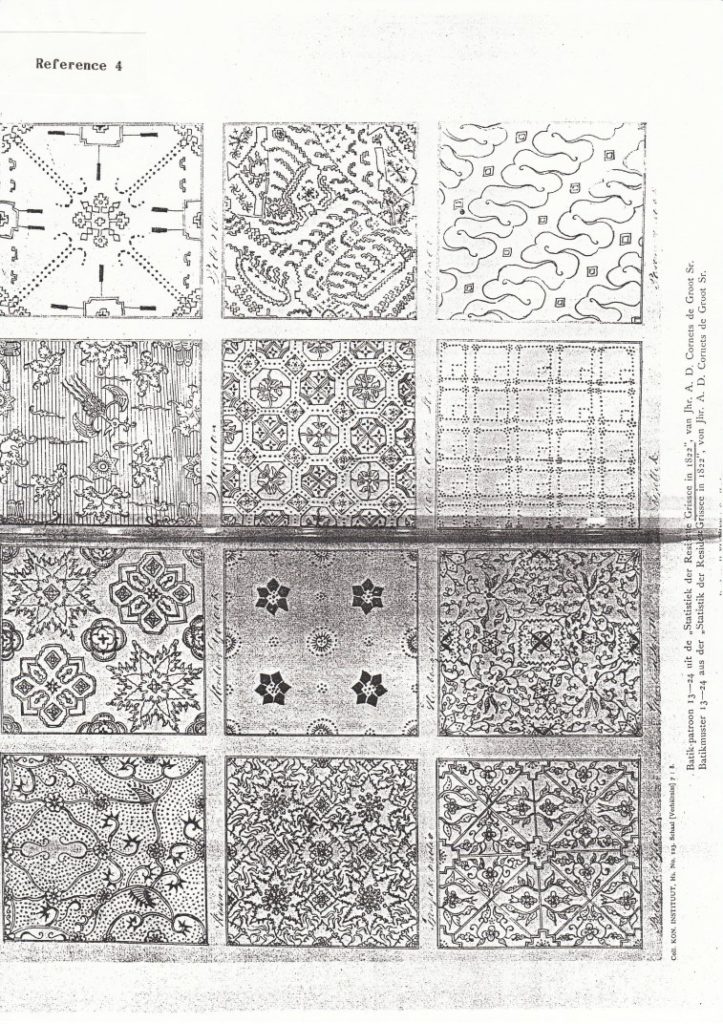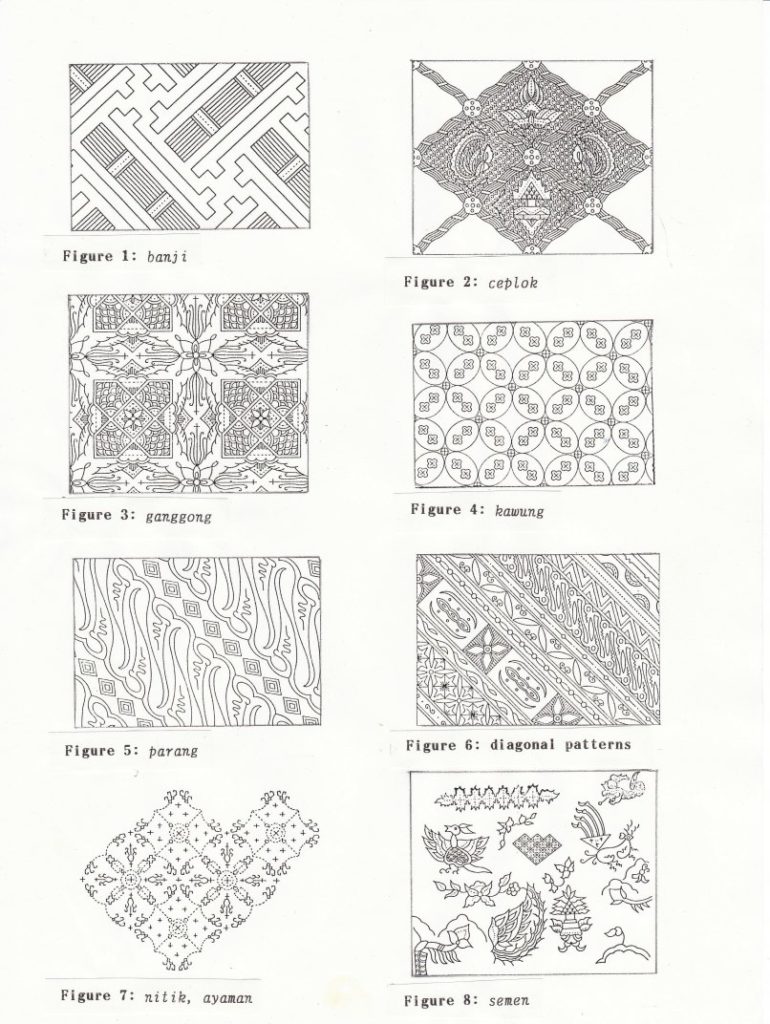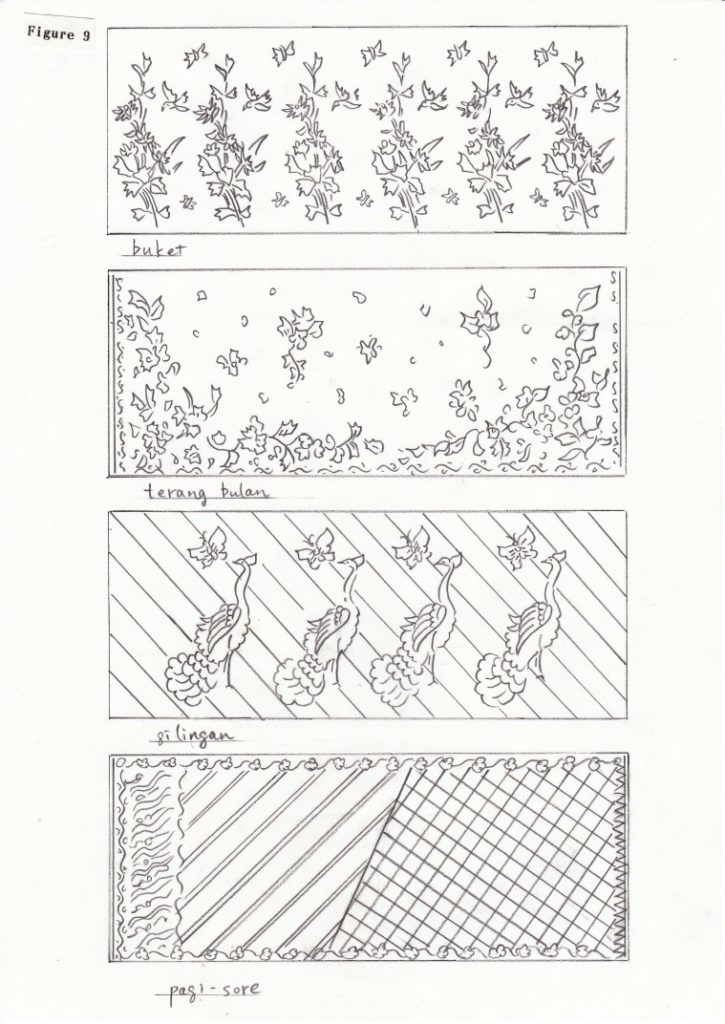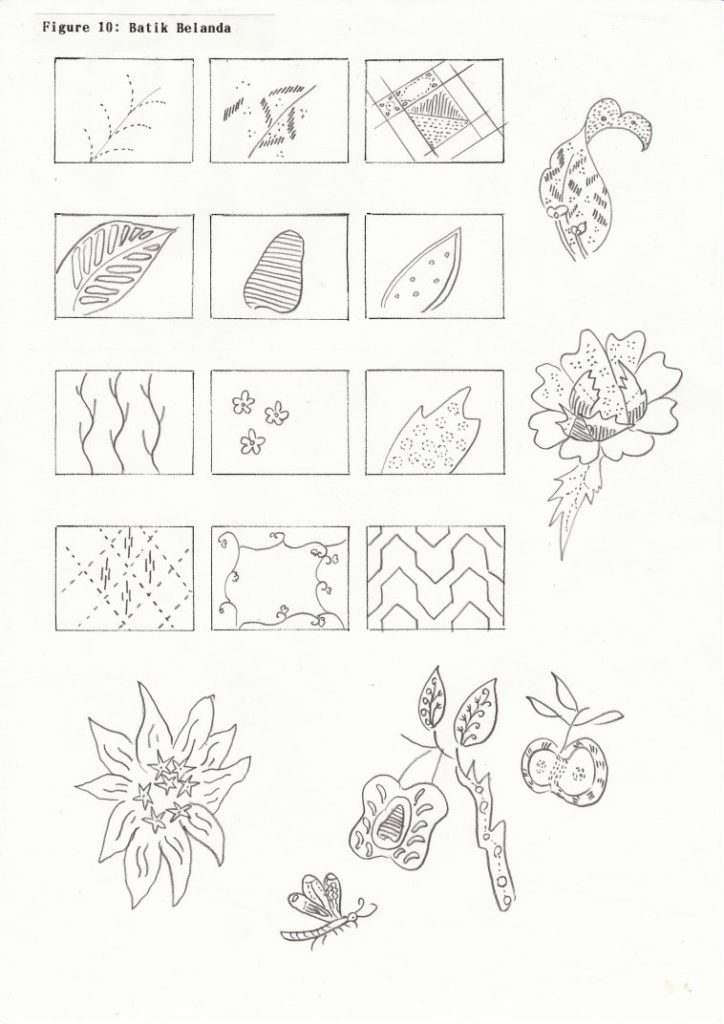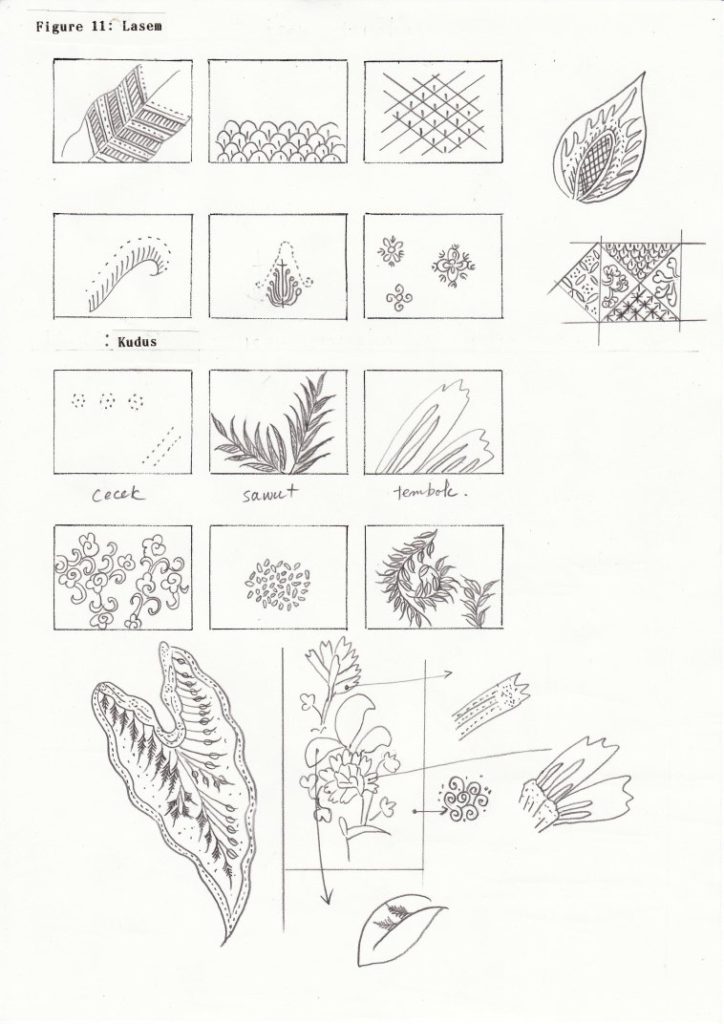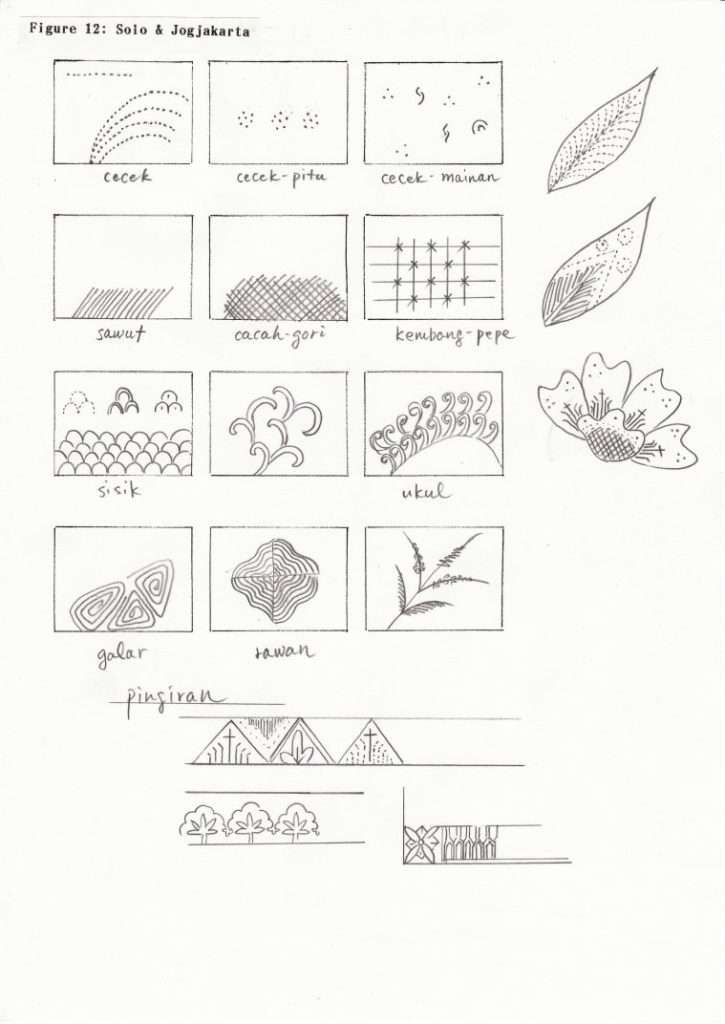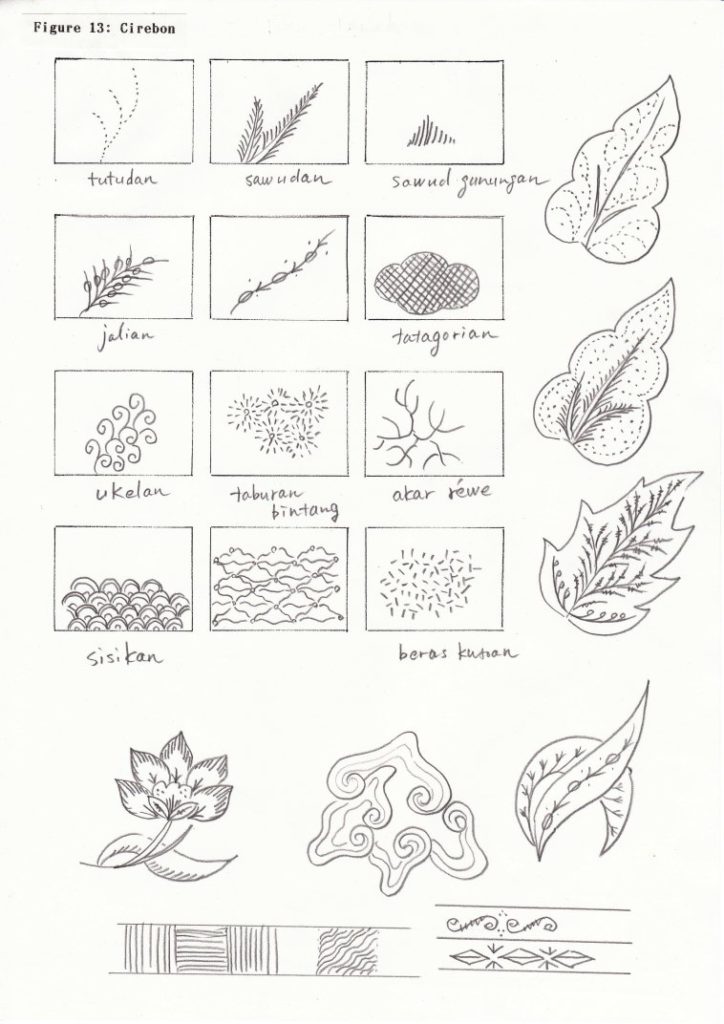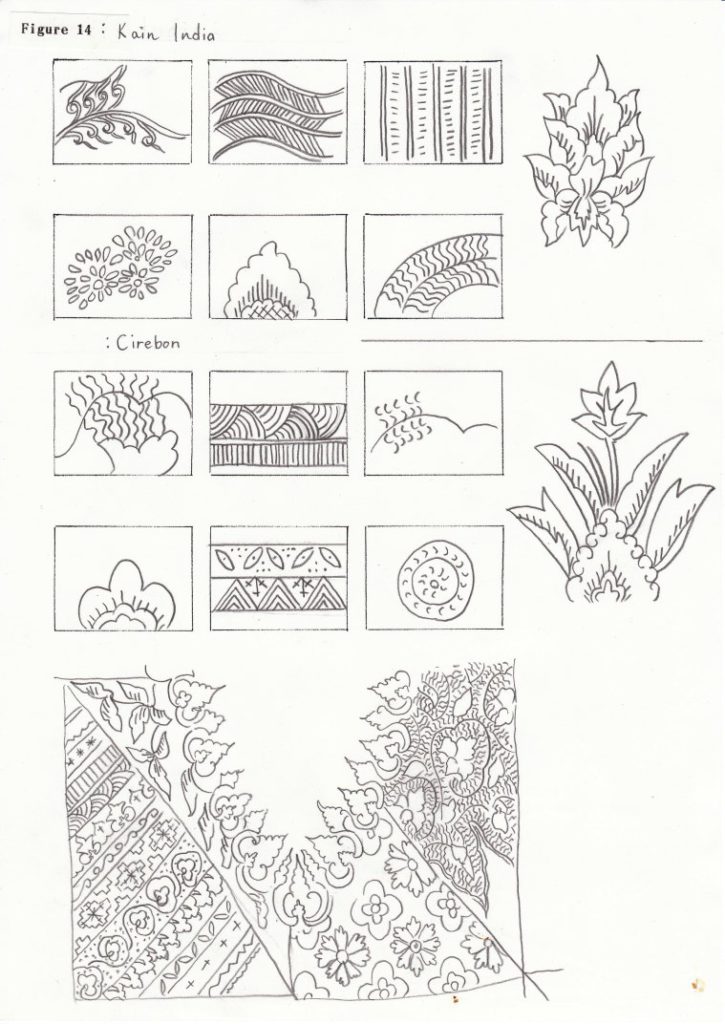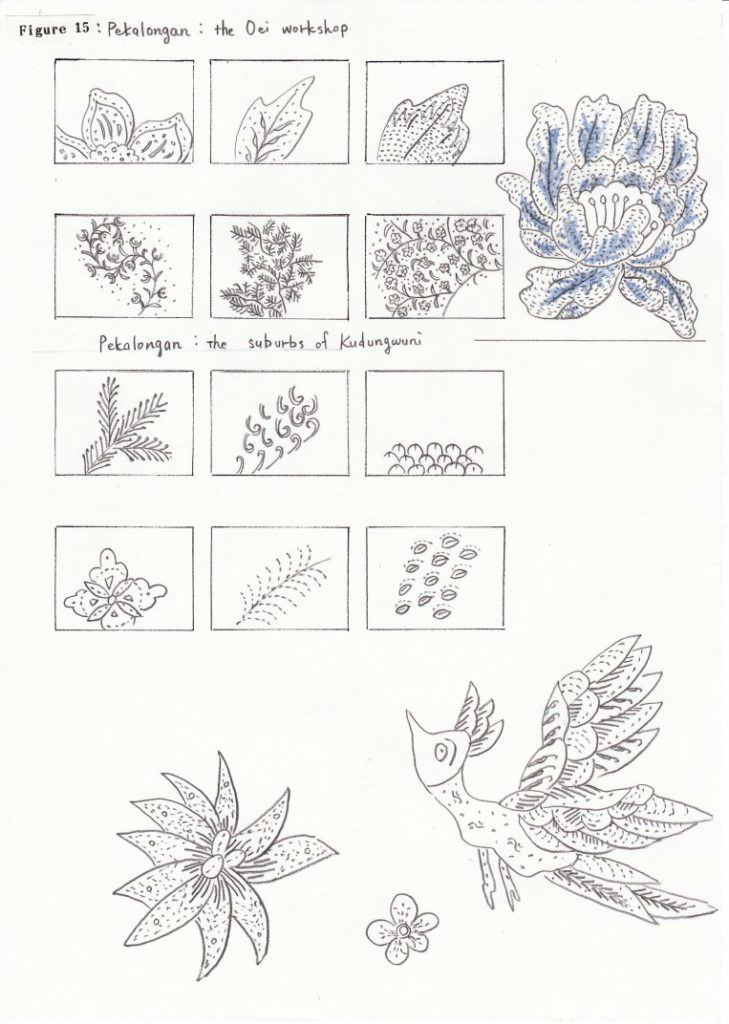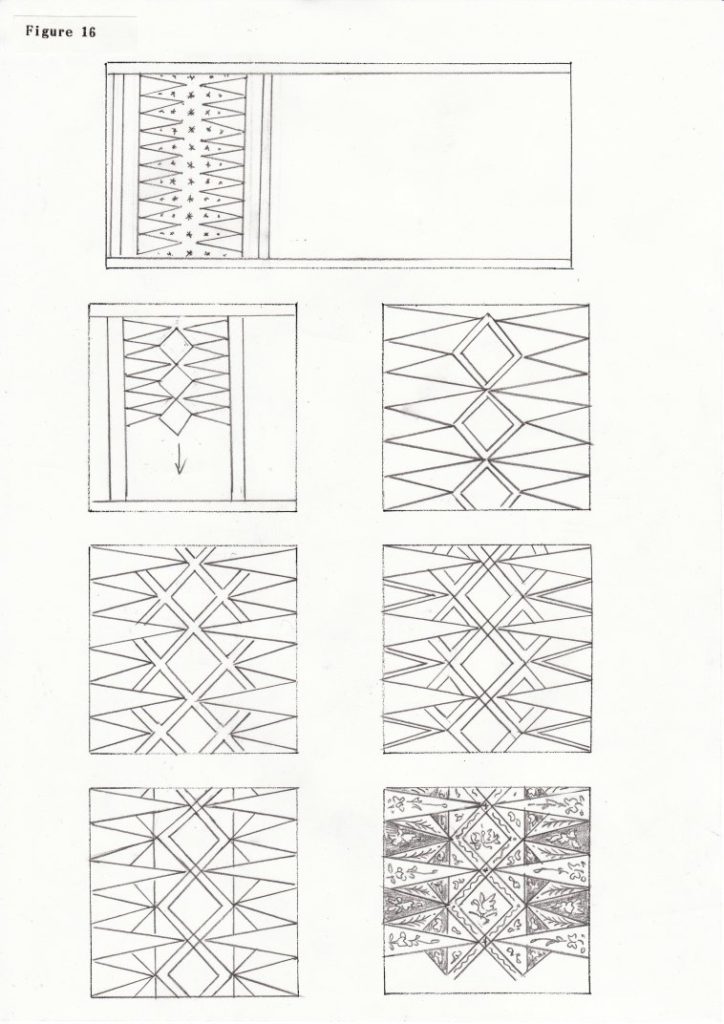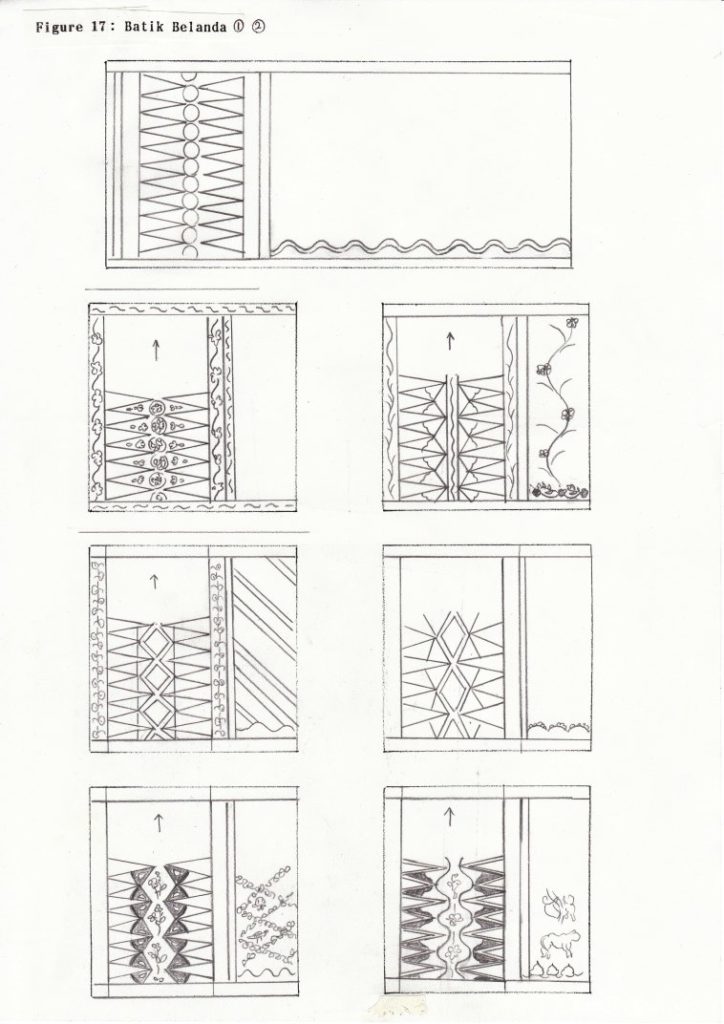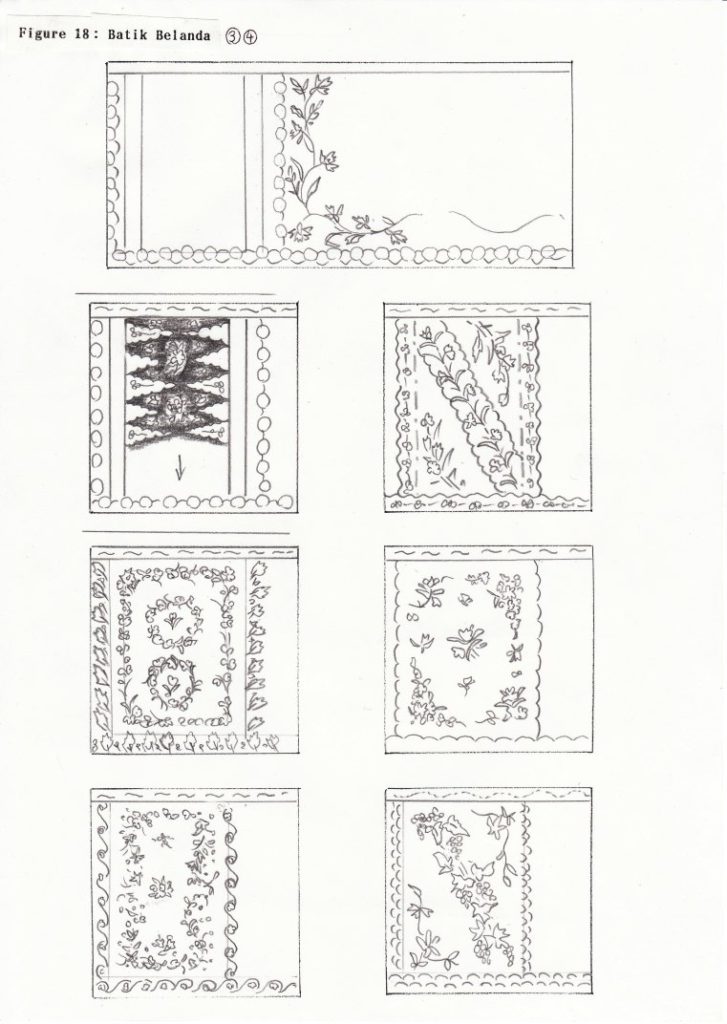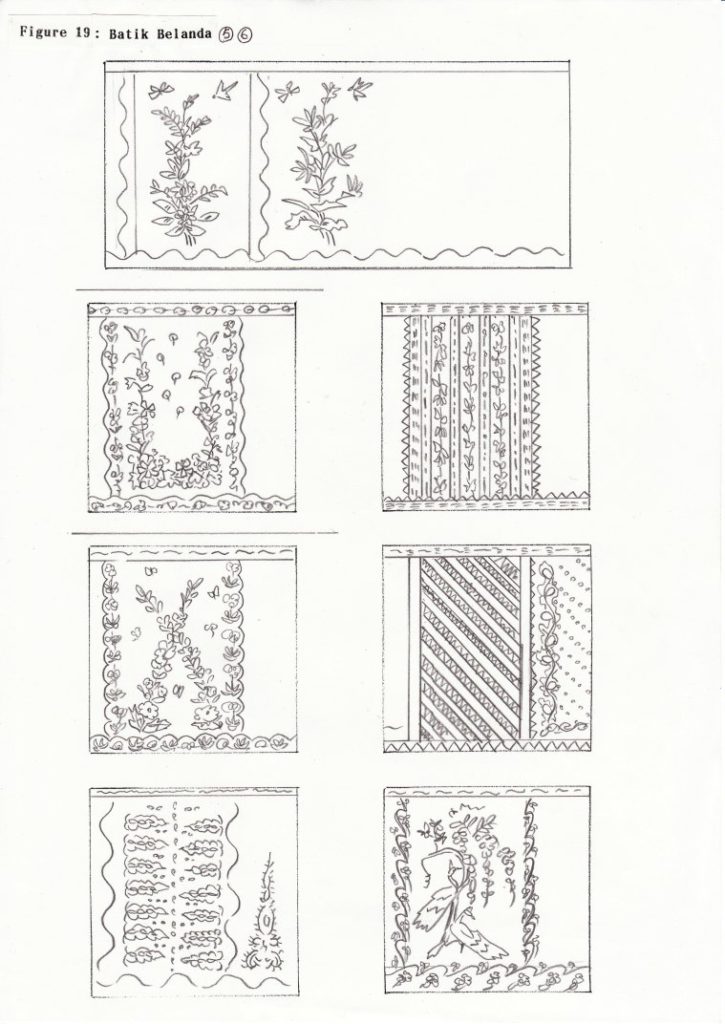JAVANESE BATIK:
CHANGING MOTIFS AND TECHNIQUES
Fusami Ito
Translated by Sachiko Aoki
Indonesian Batik is a textile produced mainly in Java, more familiarly known as “Java sarasa” in Japan. This particular kind of textile is created by wax-resist technique. Some are very expensive artworks requiring years before completion of highly intricate motifs while others are more readily available for ordinary daily use, finished within a few days. The motifs and colors of the batik vary extensively, depending on social ranks, racial backgrounds and regional differences. The main motif has a special meaning or is symbolic of a certain indigenous Javanese ritual. There are also many motifs adopted in the process of interaction with foreign countries such as European and Islamic countries, China, India and Japan. They developed into beautiful motifs blending in with the traditional. The creativity of batik, along with the advanced technique of wax-resist method, is given high recognition throughout the world.
Most of the batiks remaining to this day are estimated to date back to some time after the 19th century. However, there is little documentation giving reliable account of when and how batik was created and the history of its development leading to the traditional batik industry as practiced today. It is impossible to correlate written records on batik before the 18th century with the actual works. The age and region of batiks displayed in museums are ambiguous as the basis for estimation varies greatly even among researchers and collectors.
Involved in the art of batik-making over many years, it has been my desire to categorize the age and region of batiks and map out the history of batik from the information obtained directly from the cloth itself: namely, the motifs, color and technique employed.
The basic reference material is “De Batikkunst” which is the third volume in “De Inlandsch Kunstnijverheid in Nederlandsch Indie.” A research study published in 1916, this book outlines the background of batik up to the early 20th century, providing a rich collection of illustrations and photographs. In a separate volume to “De Batikkunst in Nederlandsch-Indie en Haar Geschindenis (co-authored by G.P. Rouffer and Dr. H.H. Juynboll)” published in 1914, there are a hundred illustrations and photographs in B4 and B3 sizes of motifs, people and materials related to batik-making (see References 1~4). Actual samples of some of the batiks illustrated in these two studies could be found in the National Museum at Jakarta and the Sonobudoyo Museum in Yogyakarta. However, there is no detailed record accompanying these batiks. Through the effort of Mr. Yosep, curator of the National Museum at Jakarta, the Museum searched in the Dutch register, but the explanations are limited to the size, place, color and motif of the work. As for the Sonobudoyo Museum, there is no indication other than the work being donated in 1935 from the Java Institute in the Netherlands, specializing in the study of Javanese culture.
Whatever the details, assuming from the content of these two studies, the works herein described are representative masterpieces of traditional batik before the 20th century. Among the batiks owned by the above two museums, some are obviously of a different older types of batik. In this present study, I decided to compare a selection of approximately 235 batiks from these two museums, about 1,500 from the Adnan Kusuma Collection (mainly batik of the north coast of Java created between the mid-19th and mid-20th century) and another 200 or so in my personal collection (mainly of Central Java, dating from the mid-19th to the 20th century). Batiks in the Toyama Collection, Okada Collection and in various workshops and collections in Indonesia have also been examined for reference. Effort was made to ascertain the year of creation, analyze the motifs and detect any change in the technique.
EXAMINATION OF BATIKS
Upon looking at a batik, the eyes first capture the color and motif. Only after that do the various questions arise as to when, where, who and how it was made. Trying to answer these questions, however, is no easy task. It is well known that batiks are very region-oriented. At the same time, it should be remembered that there are many inter-marriages between workshops and that many commercialized batik products have a tendency to rapidly adopt colors and motifs of popular demand. This makes it difficult to pinpoint the origin of its production.
However, upon closer examination there is still outstanding regional characteristics detected in the isen and tanahan motifs despite variations in color and motif. Isen is the finely-detailed, small decorative motifs arranged inside the outline of the main motif of flower, bird or geometric shapes. Depending on the area it decorates, the motifs are applied in top-bottom, left-right combination. Tanahan, on the other hand, is depicted right outside the main motif. Isen and tanahan are not contrasting motifs, but rather have many in common. Depending on the region, the same motif may be used as isen or tanahan. The strong regional characteristic of isen and tanahan is due mainly to the fact that the various steps of batik making are handled by specialists and the entire process is not completed by one person, except in the case of personal clothes made by villagers for their own use.
An owner of a workshop would make an undersketch of the general outline of a motif and hand it to a waxer (pembatik). Usually, a rough image of the basic color and isen is relayed at the time, with details left up to the pembatik. From the color designation, the pembatik would draw isen and tanahan motifs of flowers, leaves, birds and the like in a natural flow resulting from experience accumulated over the years. It is said that over a dozen different combinations of motifs are memorized and stored in the hands of pembatik workers. To introduce any change would require highly motivated efforts. I was involved in waxing at a Solo workshop for five years. Perhaps because of my experience there, whenever I do some waxing, my work takes after the isen and tanahan of the Solo style whether intended or not.
There is agreed recognition of certain names and motifs within a given region between workshop owners and waxers, regardless of different workshops, with hardly any deviation. In the vicinity of batik producing areas are villages inhabited by waxers who might at times bring home their work. This is another reason why the isen and tanahan among a region and among certain age groups begin to resemble one another very closely. But once in a different region, those same isen and tanahan may have a different touch. Of course, there has been changes with the passing of years. From this insight, isen and tanahan serve as a significant criteria in specifying the year and place of production along with considerations of motif and color.
CLASSIFICATION OF TRADITIONAL BATIK MOTIFS
The color and naming of batik vary depending on the combination of the main motif, isen and tanahan. It is said that there are over several thousand motifs which can be classified systematically into standard groups with regards to the so-called traditional batik. Once Western-style adaptation of the batik came into style in the 1970s, this standard underwent a major shift.
The earlier mentioned “De Batikkunst” of “De Inlandsch Kunstnijverheid in Nederlandsch Indie” classifies the motifs into eight groups, accompanied by detailed explanations. Adding three more groups cover approximately all the motifs of traditional batik. The 11 groups in total are as follow:
- The Banji group. A swastika-shaped motif appears in set intervals either horizontally, vertically or diagonally. Quite often it is combined with a square motif. (See Figure 1.)
- The Ceplok group. A highly stylized motif in a tile-like, uniform rectangular or circular shape is set in horizontal, vertical or diagonal combination. A similar motif is found carved in reliefs at the Prambanan Temple ruins. (See Figure 2.)
- The Ganggong group. Configuration of stylized motifs of plants and fruits growing in the Ganggong marsh and motifs taken from the Ceplok group placed in crisscross pattern. (See Figure 3.)
- The Kawung group. A variation of circular shippo motifs arranged in a lattice-like configuration. (See Figure 4.)
- The Parang group. An arrangement of S-shaped motifs generally termed parang in a diagonally parallel lines. Many of the motifs are taken from stories related to the court. (See Figure 5.)
- Diagonal patterns excepting the parang motif. A continuous motif in diagonal parallel arrangement other than the aforementioned parang group. (See Figure 6.)
- The Nitik, Anyaman group. Motifs are said to be taken from traditional silk and woven clothes of India basically arranging dots and bars in a continuous sequence. (See Figure 7.)
- The Semen group. A repetitious motif combining stylized depiction of plants, animals and garuda birds. This group can be subdivided into three smaller groupings:
(a) arrangements based on plants;
(b) arrangements based on plants and animals;
(c) arrangements based on plants, animals, garuda birds, architectural structures, mountains and others.
(See Figure 8.) - The Buket group. A large bouquet of flowers is interspersed with motifs of birds and butterflies.
- Miscellaneous which includes free arrangement of motifs varying from legends, customs, scenaries, pictorial depictions of animals and plants, etc.
- Border motif. A continuous pattern decorating the border of a cloth or around the main motif. This pattern, along with the position and combination of the main motif, gives clue to the date of the batik production.
Traditional batik in itself can be roughly divided into two types. One is the line of batik developed in Central Java closely linked to court life. The other is that developed mainly in the coastal towns of northern Java.
The main locations of batik production in Central Java are Yogyakarta and Solo (or Surakarta). The batik developed in this area is kain soga dyed in brown and navy. The making of this particular kind of batik was originally considered an artistic accomplishment expected of well-bred ladies in the high court, then gradually spreading among the more popular level. As a result, preference is given to smooth lines and sophisticated motifs in sequential pattern. The motifs belong mostly to the above groups 1~8, with some motifs prohibited to be worn by those outside the royal household in the prewar days. The once prohibited motifs can now be worn by any person, but even to this day are restricted upon entering the palace in Yogyakarta.
The north coast batik, on the other hand, includes those created in the northern coastal area of Java and the region around Madura Island. The production centers are in Indramayu, Cirebon, Pekalongan, Lasem, Kudus, Tuban, and Madura (Pamekasan, Sampang, and Tanjungbumi). They are mainly seaports which prospered through trade. The production was supported mainly by people of Dutch, Arab and Chinese background, with native Indonesians in the area taking part in the planning. Together with other specialties of the region, batik became an important merchandise for trade and was quick to take in the trends of the time in the process of its development. At times, members of fishing or trading vessels brought home materials to create batik and played a role in propagating and expanding the technique of batik. All such creations are part of what is known as the north-coast batik. The motifs show more clearly traces of Indian, European and Chinese influence as compared to Central Javanese batik. The motifs show more clearly traces of Indian, European and Chinese influences as compared to Central Javanese batik. There are also many with freer pictorial motifs. Many belong to groups 9 and 10, with a great number including original motifs inspired by strongly regional products from the sea.
Looking at the isen and tanahan, they are closely related to the naming and coloring of motifs. Contemporary isen and tanahan are based on kain soga of Central Java. Isen and tanahan are drawn by wax-resist. In the case of kain soga, it is necessary to choose whether to make the color of the motif and the background color brown, navy or leave them in their original color. For example, in a dotted design, the dots remain white and the background is dyed in navy. In a linear design, the line becomes brown and the background navy. When the cloth is to retain its white color, the motif must be framed in double lines or select a motif drawn in double lines. Examples of isen and tanahan are shown in Figures 10 to 13.
The Central Java batik is known for a rich variety of isen motifs while the number is limited for north-coast batik, with an inclination to prefer certain motifs depending on the region. And often the isen motif is employed as tanahan, as mentioned earlier. The batik of Madura Island is an example of tanahan holding the key to the identification since the tanahan name becomes the name of the batik.
NAMES OF TRADITIONAL BATIK
Batiks are name systematically. The basis for the systematic naming derives from Central Javanese batik. The names are such that the general composition of the motifs can more or less be determined. The most common naming is a combination of the name of the main motif and the ground color. The name of the main motif, in such a case, is usually the group name plus an individual name or just the individual name. Names of familiar animals and plants, natural phenomenon, wish or talisman are selected as individual names. For example:
Ceplok Mangis (Mangostine fruit)
Pisang Bali (Bali banana)
Kembang cengkeh (clove flower)
Grompol (coconut)
Ganggong Madubroto (safe to come close to Ganggong)
Udan lilis (light rain)
Sido Luhur (easily reaching the summit without obstacles)
Parang Menang (victorious Parang).
Often these names are followed by ground color names such as:
latar ireng (dark navy)
latar putih (brown with ukel)
bledak (white).
Instead of the color names, geological names at times may follow the above individual names. The exception is Sido Luhur which is always dyed in dark navy. This particular motif is often worn for ceremonies of celebration and the individual names vary with the change in ground color (the change in tanahan). Examples include:
Sido Mulyo (white ground color)
Sido Mukti (the motif, ukel and ground color are all reddish brown)
Wirasat (a design combining the above three in alternate order).
When there are more than two main motifs, individual names are added before and after, such as --- Seling ---. When the entire work is divided into squares employing various different motifs, it is called tambel. When the divisions are freer and in more circular lines, it is called Sekar Jagad.
The Central Javanese batik emphasizes a refined style and spiritual motifs, while the batik of the north coast employs more familiar motifs inspired by animals and plants. Of course, the naming of the batik also derives from such names. This is because the former is closely related to court rituals and has been developed in the high courts of the sultans while the latter has its roots in commercial interest. The only exception is the batik produced in Paseseh of Madura where the motif name comes from the basic pattern name.
Another aspect of batik names is the set of names based on the color dye employed, aside from motif names. They are:
Kelangan (blue, light and dark blue)
Bang-bangan (red, light and dark red)
Bang-biru (red and blue colors)
Bang-biru-ijo (red, blue and green made of blue and yellow)
Kain-ungon (mainly the purple obtained by overlapping red and blue)
Bang-ungon (more red than in Kain-ungon)
Tiga-negeri (red, blue, brown)
Empat-negeri (red, blue, brown, green, purple)
Kain-prada (gold print)
Kain-mas (navy, golden brown)
Batik names of the north coast of Java, in particular, are known to combine names of the color and the motif, with greater emphasis laid on the color name. The batik names, as the motifs themselves, have tended to undergo gradual subdivisions, expanding and adopting themselves into the daily lives of the people as part of their language. As a result, the design may have underwent changes even though termed under the same name.
Sido Mukti and Sekar Jagad are good examples of batik whose standards of how they are made have changed according to different regions. There are others with special naming but have been omitted in this present study.
DETERMINING THE AGE OF BATIK AND BATIK BELANDA
Since when did “regional” characteristics mark an obvious trait in the color, motif and technique of batik making in the various parts of Java? And what kind of changes did they undergo? According to the earlier mentioned “De Inlandsche Kunstnijverheid in Nederlandsch Indie,” kain soga began to be produced in the 17th century following the discovery of the Soga dye (taken from the bark and trunk of trees to obtain yellow, brown and reddish brown dyes). Likewise, kain bang-bangan of the north coast of Java prospered in the 18th century. However, in view of the Indonesian climate, the works of batik now remaining are considered to date from the 19th century onward. It would seem most natural for textile put to ordinary use to last no more than one to two centuries. Especially in the case of batik, it is usually first worn as holiday clothes, then daily wear, later recycled into diapers and rags until completely worn out. Special ceremonial garments and formal outfits used only on limited number of occasions are generally passed down the generation intact. Most often, they are of sturdy make using beautiful colors. Therefore, it is necessary to consider the purpose of the cloth’s usage upon considering the age of a given batik.
Fortunately, Harman C. Veldhuisen has published in 1993 a book entitled “Batik Belanda 1840-1940.” Batik Belanda refers to the batik produced mainly by Dutch workshops in Indonesia. This book records the batik by each workshop in chronological order. Batik Belanda was produced primarily as wardrobe targeted at wealthy European and Chinese people living in Indonesia from the mid-19th century up to the outburst of World War II. Using this book as reference, the dates of the Batik Belanda in the Kusuma Collection can be estimated.
Referring to “De Batikkunst,” traditional batiks and their regional characteristics are compared between those created up to the early 20th century and the contemporary versions. It is obvious that Batik Belanda left a deep impression on the development of batik on the north coast. In particular, the batik produced by the Chinese living in Pekalongan follow the Batik Belanda, both in color and motif, and their characteristics have now become those associated with the Pekalongan batik. The first step thus is to analyze the design composition, major motifs, isen, and tanahan, and changes in color.
Quite different from other batiks of the time, Batik Belanda is characterized by a strong originality varying from one workshop to another. Each individual piece of batik is signed, indicating the origin of the workshop. It is also noted for appealing patterns stressing fashionability that surpasses the realm of a cloth to be simply wrapped around the waist. The basic width and length of the material remain more or less the same, but the traditional arrangement of the pattern underwent drastic change. This trend is particularly obvious in sarong, that sews the two ends together into a loop to slip over the waist. An ordinary sarong usually is composed of a major motif called badan and rectangular motifs called kepala (occupying almost a quarter of the entire cloth) that mainly decorates the front, filled in rectangular-shaped kumodo measuring approximately 8-10 cm. A fringe pattern called pinggiran framing the badan and kepala completes the picture.
In Batik Belanda, various changes were introduced to the design of the badan and pinggiran. Existing batik said to date from the mid-19th century almost always employs isosceles triangles called tumpal for the kepala motif. Most of them fill in the space between one tumpal and another with small ornaments or ornaments sectioned into diamonds and triangular shapes. The early works of Batik Belanda tend to follow this style, but from the latter half of the 19th century are completely new kepala motifs based on flowers (see Figure 9). Works from representative workshops are examined to assess the number of arrangements and their changes.
- Von Franquemont workshop: Semarang
- Same size tumpal face each other from the two sides (approximately 14 to 16 tumpals on one side), filled in with small flowers.
- Small and large tumpals are placed consecutively, facing each other. The vertex of the small tumpal and that of the large tumpal are connected to form rectangular shapes in which are small floral designs.
- Van Oosterom workshop: Banyumas
- Straight or wavy lines drawn between large and small tumpals facing each other create small divided areas. In the past, many works showed simple change of color by using only one color for the inside of kepala or changing just the tumpal part. However, this workshop does not apply color in a uniform way, but rather, places emphasis on intentional contrast between areas with a concentration of color application and others with sparse use of color. When using multiple dyes, the overall arrangement of colors is considered a part of the design.
- B. Fister workshop: Pekalongan
- Inside and outside the tumpal are original floral designs without making use of existing basic motifs.
- The kepala is roughly divided into two by diagonal arrangement of a continuous floral pattern, each filled in with flowers.
- The kepala is not partitioned with lines, but rather with motifs of floral bouquets.
- This workshop is said to be the first to sign their work.A lacework border motif surrounds the pinggiran coordinated in matching color to the kepala.
- J. Jans workshop: Pekalongan
- Floral arabesque pattern creates a floral ring for the kepala, surrounded in itself by a flower-designed arabesque.
- Even when employing a traditional geometric design for the badan, the white background play an important role, aiming to harmonize the traditional and newly created patterns in a subdued tone.
- L. Metzlaar workshop: Pekalongan
- The kepala is divided vertically with woven patterns, alternately filled in with floral arabesque design for a contrasting effect.
- The work gives off a sharp image, highlighting the dark and light color hues of navy.
- E. v. Zuylen workshop: Pekalongan
- Large floral bouquets (buket) compose the kepala, surrounded by butterflies and birds.
- Flowers are crisscrossed from the bottom.
- Arrangements are composed of badan and patterns called terang-bulan.
- Woven patterns are arranged diagonally.
- Original motifs have been created and arranged.
- Same motifs are used for badan and kepala, with reversed application of colors.
There are many other workshops, but the above have been selected for having shown changes in the motifs and their arrangements.
Of the above, 1 and 2 date from the early period of the 1840s to the 1860s. The configuration of kepala and pinggiran follow the traditional practice of batik-making, but are more pictorial, based on motifs taken from stories and legends, mostly children’s tales and poems. While continuous patterns in traditional batik combined geometric motifs taken from familiar animals and plants such as parang, kawung and ceplok, these particular batiks adapted figurative motifs with strong visual impact. The colors are not evenly applied, but rather, matched to accentuate the themes of the motifs.
Those categorized under 3 and 4 are of the middle term dating from 1870 to the end of the 19th century. The center of their production is Pekalongan. The motifs are more ornamental, combining lacework designs, bouquets, flower baskets and fruits, for the most part without a ground pattern. If and when employing a ground pattern, it is solely to highlight the main motif.
The batik of 5 and 6 are from the final period spanning from the middle term up to 1940. The main style arranges flower bouquets to cover completely the entire width of the material, now a central product of the Pekalongan batik. They encompass a wide variety of motifs from the more casual taking hint from art nouveau and art deco styles and arranging on playing cards, fans and rackets, to the more traditional taken from those of Central Java. Kain panjang (clothes to wrap around the waist) is as popularly produced as sarong. There are also many created in the pagi-sore style whereby the motifs differ from the right to the left side of the centerline and the terang bulan style where the motifs gradually become smaller from the hem towards the waist.
Even with regards to isen and tanahan, original creations aiming for greater color effects were introduced along with changes in the motifs and arrangements. In the traditional batik of earlier times, isen and tanahan existed simply to fill in the free spaces. However, in Batik Belanda, they are employed to enhance the main motif upon wearing it as a garment. To serve this purpose, what was once of uniform size and distribution came to be dispersed at random, sometimes in sparse spacing, other times more concentrated, and in various sizes. As a result, the color gradation effect rose and accentuated the coloring of the free space areas. Examples of such isen and tanahan are shown in Figures 16~19.
Batik Belanda gives high priority to the colors and pictorial composition, paying close attention to the smallest details, but is not particular about each individual waxed lines or canting. Rather than drawing even, uniform lines of the same quality throughout the entire work, the lines are drawn more simply to complete the motifs in rapid efficiency.
Up to the Second World War, the main motifs were of European taste in bright colors. However, under Japanese occupation, some workshops were forced under Japanese military orders to create batiks geared toward Japanese preference, used mainly for rewards. After the war, whatever little production of the batik in bright colors arranging large flowers for the kepala motif was succeeded by workshops owned by Chinese descendants in Pekalongan and came to compose the mainstream of the present Pekalongan batik.
The differences between Batik Belanda and other batiks made up to that time can be summarized as follows.
- Changes in the composition of motifs
- The tumpal motif within the kepala was omitted to be replaced by freer composition, centering on floral motifs such as a circular arrangement of flowers, a bouquet or in arabesque arrangement.
- The pinggiran used to employ geometric or arabesque patterns in a framework of set width, going all around the border of a work. However, adherence to the traditional sarong composition no longer governed the making of batiks and at times completely different motifs were used for the top and the bottom of a cloth in varied sizes.
- Changes in the motif
- Mere copying of traditional motifs no longer ruled. Instead European-styled floral designs were adopted and arranged into the traditional motifs.
- Drawing by dots became popular for isen, with emphasis on the finished color. Flowers were dyed in resemblance of their natural colors.
- Whilst the main motif, isen and tanahan were of equal distribution in earlier works, tanahan dropped to a minor position for a more lucid style emphasizing the main motif.
- Subjects of the main motif expanded to encompass a wider variety of greater pictorial significance taken from legends, poems and floral bouquets. Designs in popular demand for wallpapers and picture postcards were also taken in and adopted into the main motif.
- Changes in color
- While the color effect of traditional batik was rather confused, Batik Belanda used the free space effectively for a smarter and more lucid finish.
- Since the introduction of chemical dyes in the 1920s, pink and purple coloring also became possible. Since the 1930s, a colorful batik employing multiple dyes came to occupy the bulk of batiks.
In the 100 years between 1840 and 1940, Batik Belanda underwent numerous changes in style and color, in pursuit of popular motifs and colors. After its example, the Chinese-owned workshops in Pekalongan followed suit in making major changes, which in turn led to influence the nearby north-coast batik. Until the introduction of these changes, batiks generally continued to be created in faithful execution of existing motifs and technique passed down the generations.
BATIKS BY REGION FROM THE 19TH TO THE 20TH CENTURY
Regional development of batik up to the mid-20th century is followed by studies made of batik workshops and actual samples. A preliminary step is to give consideration to the invention of cap (a copper stamp that applies wax over a small area of the cloth in a fixed pattern) around 1860 and import of cheap wax from Europe, the use of inexpensive paraffin produced in Java since 1905, and the introduction of synthetic dyes from around the 1920s. These facts altered the near exclusive production of hand-painted works toward cheaper mass production. On the other hand, possession of expensive hand-painted works became status symbols for the wealthy who could discern the quality of the work, and fueled the competition toward higher artistic achievement.
1. Pekalongan (refer to Figures 10 and 15):
In Pekalongan, survey was conducted by visiting the Oei Soe Tjoen workshop in Kudungwuni and adjacent workshops in and around the area, including Ahmad Yahya, Ratu Manis, Ahmad Basmeleh and Ridaka. There were hardly any samples left from before the 20th century, but the style and production process of the previous and even of two generations earlier were assessed through interviews and examination of batiks in museums and in the hands of collectors. The discerning eyes of antique dealers in Jakarta and Pekalongan also turned out very useful.
Study of the Oei workshop show how the buket motif considered to be representative of contemporary Pekalongan batik was developed. The buket of the Oei workshop is covered entirely by dotted isen and arabesque-patterned tanahan, separately dyed using nine to ten colors in various hues. This is the most popular style now, becoming a classic with hardly any change introduced besides the slight variation in color. The style was completed one generation ago by the previous owner of the Oei workshop, and carried in faithful reproduction by the present owner.
The wife of the previous head of the workshop came from Batang and is said to have started making a higher quality hand-drawn batik from 1924 onwards. Until then, most of the batik made by Oei was not considered of top quality. The house of the wife’s parents specialized in quality hand-drawn batik based on parang and kawung called bang-biru considered most common in north-coast batik. She was thus not familiar with buket, but showed exceptional talent in color application and had a good sense of style. Once she got involved in her husband’s workshop, her works taking after the Van Zuylen style became very popular. Under he leadership, the workshop reached its peak, employing approximately 150 pembatiks (waxers) at one time. In the 1920s and 1930s, the buket motif is produced on an extensive scale by Chinese-owned workshops. With the introduction of synthetic dyes, the colors become more vivid and helped create brightly colored batiks. Popular designs were quick to be imitated by others.
The earlier works of the Oei workshop have simple isen and tanahan aimed to enhance the main motif. As competition increased with a lot of imitations going around, the isen and tanahan became more and more complicated. Instead of employing the more traditional motifs of parang and kawung for the tanahan, original designs measuring about 5mm or so were created, combined with arabesque or dotted patterns which required more and more refined wax-drawing technique. This is not unique to the Oei workshop. From the 1930s to the beginning of the war, Chinese workshops of the north coast unfolded a heated competition for sophistication in wax-drawn lines. As a result, waxing technique reached a high stage of perfection and isen and tanahan became multi-colored, refined works of originality.
Alongside the batik production by the Chinese undergoing various changes since the 1920s, there is also a particular kind of batik that has continued to be made since the 19th century with hardly any change. Made in the Arab-owned workshops in Krapyak Lor village within Pekalongan, it is called “Batik Jlamprang” known for designs taken from woven textile. In the classification of traditional batiks, it falls under the category of nitik and anyaman groups. Most famous for motifs inspired after the Indian patola the classification of traditional batiks, it falls under the category of, it continues to be made to this day, with over a dozen variations. The contemporary version is made in combination wit the use of Batik cap, but according to the workshop owners, it used to be all hand-drawn until the world war. The motifs are mostly unchanged throughout the generations. The color is bang-biru overlapped with tiga-negeri. The old types are said to be bang-biru. Those dyed in yellow over the tiga-negeri are called laseman. The origin of Batik Jlamprang in this region is uncertain. However, the motif itself is said to have been in production already in the early 19th century.
In the suburbs of Kudingwuni are also batiks made for private use, little affected by outside influence. They are generally called bang-biru and tiga-negeri, taken from their color names. However, from the viewpoint of motifs, the same batiks are termed Sido Mukti and Sekar Jagad. As for the Mukti motif, it is thought to be a variation of Sido Mukti of Central Java. The overall divisions in rectangular shapes of the motif outline is the same as that of Central Java, but the tip of the ukul of the isen motif forms a short parallel line rather than curling in like a bracken. Garuda birds and architectural structures are not used for motifs on the inside. Instead are simplified designs of flowers and leaves drawn in casual strokes. The number of different motifs are limited, repeating whatever designs are available. An old woman who claimed to be 80 (in 1997) insisted that the designs have not changed since the days of her ancestors. The only difference from the older batiks is material used for dyes which was all taken from plants in the earlier days.
There are many other workshops of Arab, Chinese and Indonesian background in Pekalongan. The central item of production is the multi-colored batiks using Batik cap, made after the turn of the century.
2. Lasem and its vicinity (refer to Figure 11):
Lasem is well-known as one of the most important production center of the north coast batik called bang-biru and bang-biru-ijo. Batik Beland created in the 1840s also takes root in these north coast batiks. Among the towns in the north coast, some have underwent changes in color and design to meet the demands as in the case of Pekalongan. However, the area around Lasem continued to produce batiks without deviating from the basic qualities associated with north-coast batik. This adherence to the same style is not due to the desire to protect the tradition as in Central Java, but rather the extremely closed nature of the workshops in this area. Batik workshops in general have a tendency to be closed to contain the secrets of the dye, but the trend seems even more obvious in Lasem. Batiks are mainly produced in Chinese-owned workshops and traded as an important merchandise from very early on. They were particularly favored by traders in Sumatra and many were ordered for export purposes. The most popular products were kain panjang which arranges the tumpal on the inner edge of the cloth, framed by the border pattern of pinggiran, and a sarong which combines temples to create a cappella. The arrangement of these tumpals and the border pattern is an important key to determining the age of the batik.
In the earlier works, the tumpals are of uniform size and the color composition is very simple. The outline of the main motif is given greater emphasis than to the ornamental motifs of isen and tanahan. On the border of the kepala are motifs which appear to be taken from Indian prints. Among this group of batiks is kain Jambi which was a favorite of the Jambi people in Sumatra. The tumpals on both ends and the border pattern in dark red act like a frame that contains motifs from the ceplok and semen groups, dyed mainly in dark navy. The earlier clothes are most likely to have been dyed in the areas around Lasem. The motifs and their arrangement are surprisingly similar to the Indian prints extensively imported to Sumatra in the 18th century. The production of kain Jambi is estimated to have started at the latest by the early 19th century. A great number continued to be created for trade with Sumatra. Although the motifs underwent changes, the dark tones of dark navy and dark red remained for the most part.
From the viewpoint of waxing, there is hardly any trace of painstaking care given to details. In contrast, there are many superb works in hand-drawn batiks like bang-biru and bang-biru-ijo intended for trade within Java. However, it should be remembered that the technical level of wax-drawing and dyeing between the mid-19th century and early 20th century was extremely high in the north coast, not only in Lasem alone. And there are a lot of common traits in the animal/plant and geometric motifs. These all make the process of distinguishing the location of the production extremely difficult. Even so, bang-biru and tiga-negeri of Lasem are widely known under the name of laseman.
In Juwono located in the vicinity of Lasem, silk batik (Lok Can) of strong Chinese characteristics have been produced. In Kudus, Soga batik with unique isen and tanahan motifs have been made. However, batik produced in Lasem in our times is mostly of coarse quality and batiks of the above kind are no longer being produced in Juwono and Kundus.
Bang-biru and bang-biru-ijo carrying on the characteristics of north coast batik are made even at present in Tanjung Bumi of Madura. In the village of Peseseh still remain what are considered motifs made in the 19th century and their manner of production.
3. Solo and Yogyakarta (refer to Figure 12):
Solo and Yogyakarta are both ancient cities with palaces of the sultan, descending from the great Mataram Empire. Batiks were made in the court as a basic accomplishment of women in the royal and aristocratic families. There is even a legend of the origin of the parang motif associated with the last of the Mataram dynasty, Sultan Agun. Through various rituals and ceremonies, batik and the court were closely interrelated. Among the batiks created as court costumes are dodot (cloth worn for ceremonies and dancing, measuring about four times the ordinary size) and kemben (breastcloth) which employs motifs dating back to before the 18th century.
Soga batik of Central Java are composed of two-color dyes of brown and navy. The brown dye is made of barks and trunks taken from three different kinds of trees. Depending on its ratio, it is possible to obtain various shades of color ranging from a yellowish brown to reddish and dark brown. Up to the 19th century, motifs of parang, kawung and semen formed the bulk and preference was given to combining tambal, Sekar Jagad and various other motifs in a patchwork-like arrangement. The batiks produced mainly in the court gradually entailed the wealthy class and reached the popular class by the 19th century.
In the latter half of the century, those who made a fortune with the use of Batik cap obtained enormous estates. In Solo the wealthy mansions are concentrated in the Lawiyau district. Within the highly-fenced in estates of more than several thousand tsubo (1 tsubo=3.954 square yds.) are stately mansions adorned with colorful stained glasses. In the rear are batik workshops. Owners of large workshops had fashionable hand-drawn batiks made for their family. These batiks have playful elements of unending interest within the composition of basic traditional motifs. The isen and tanahan are also made of amusing motifs. However, the quest for high quality and elegance is always there and the outlines are meticulously drawn in even smooth lines.
Basically the motifs used for Solo and Yogyakarta batiks are the same. The difference is while the Yogyakarta batiks maintain the white for the background, the Solo batiks add a yellowish brown dye upon washing off the wax and thus have an overall finish of light brown background.
4. Cirebon (refer to Figures 13 and 14):
Cirebon is the former capital of the Islamic kingdom established by Sunan Gunang Jati in the 16th century. There is even to this day remains of the old palaces. Sunan Gunung Jati had taken control of the Lampung district in Sumatra, the producing center of pepper, in the 16th century. In about the last five or six years, the antique markets are being flooded with Indian sarasa called kain India coming from Lampung. This kain India was a thin cloth produced for export to Lampung and is very similar to batiks in terms of arranging the tumpal on both sides and the composition of motifs. The same motifs are actually found in batiks made in the Cirebon palace now kept in the National Museum at Jakarta, Sonobudoyo Museum and the archive of the palace itself. These batiks are of dark and light navy or dark and light navy and red, better known as kain biron and bang-biru. Using a hand-woven cloth, these batiks obviously appear to trace back to an earlier generation than the others.
The same motifs used in the Indian prints exported to Indonesia are found in another kind of Indian prints that was introduced in Japan and has been passed down as the Hikone sarasa. The earlier works of this Hikone sarasa are estimated to date from the 17th century and similar prints are in the archives of the Cirebon palace. However, there is no written explanation in the palace archive to give clue to any common history. The only known fact is that kain India was imported into Lampung over several centuries. The earlier works were of fine quality, thin cloth with delicate wax drawings by hand. As time passed, the motifs become more coarse and done by machines. It is highly likely that the drawing of the early works became models for the isen and tanahan of batiks. There are many common characteristics found between the two, including the lines drawn on the inner side of the outline of the motif, the arranging of free space and the size of the motifs. The curving outline of flowers and leaves and the arrangement of smaller motifs are all drawn employing the same touch. Since these very same motifs also have much in common with woven textiles of India and Sumatra, it is difficult to ascertain which influenced which without uncovering new facts.
Whatever the historical background, the impact of kain India on the Cirebon court batiks was great in the 17th and 18th centuries. The old batiks of Cirebon now in the collection of the palace archive and museums may possibly have been produced before the 18th century. Even if not so, these batiks have continued to adhere to the tradition and may be considered to be in the middle between court batiks of Central Java and those of Cirebon.
Turning back to batiks produced from end 19th to the 20th century, the Cirebon batiks have some motifs unique to Cirebon such as wadasan (inspired by the palace gardens and literature) and clouds. Another characteristic is the original arrangement of parang and semen motifs. These motifs and all over the pinggiran decorating the rim are remnants of the old batiks. The number of motifs cover a wide compass. Among them are many that actively adopted and fused in ideas from Chinese, Indian, and Islamic chinaware, textiles, arts and crafts and familiar animals and plants. The motifs are sketched in a dynamic outline. The batiks are usually finished without any design in the background and without making frequent use of the tanahan.
A finely drawn motif on a clear white background is considered of high quality and there is high competition to master the technique. Quite often the white has turned into an ivory color. This is because after the final washing of the wax, in the case of a plant-based dye, slight coloring occurs. After switching to the use of artificial dyes, the finished work is dyed into ivory color at the final stage. The smart impression despite its use of multiple colors and extensive variations of motifs with little use of tanahan allowed this batik to continue a steady production whilst many good-quality hand-drawn batiks rapidly showed a decline in production. The batik is made mainly in the area surrounding Turusmi without much deviation from the traditional motifs.
To summarize briefly, the basics of traditional batiks known today were already perfected by the early 19th century. From the mid-19th to the 20th century, cheap access to necessary materials permitted a spread in batik-making and led to the regional competition to create original works. The main motif underwent changes as it incorporated the popular taste, but isen, tanahan and border patterns for the most part continued in the same tradition. There are also regional color variations, especially in dyes of blue, red and brown, not mentioned in detail in this study. This is due mainly to the different water quality and the difference in the dying process by region and contribute to the creation of regional characteristics.
There are batiks said to date from the early 18th century. They are batiks of the Cirebon court. Among them is a work drawn on silk. It is not known whether this work is in mid-position between the kain India and batik or if it happened to be created at the same time. As the discovery of massive quantities of kain India led to new understandings obtained from comparing it to Hikone sarasa, I sincerely hope that more documents can be found to shed light to the understanding of batiks.
Handicrafts and Industrial Development in Southeast Asia
(leader:Professor Teruo Sekimoto Institute of OrientalCulture,Tokyo University)

